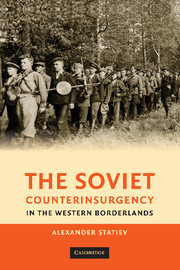Book contents
- Frontmatter
- Contents
- List of Figures
- List of Tables
- Acknowledgments
- Glossary
- Introduction
- 1 Origins of Soviet Counterinsurgency
- 2 The Borderland Societies in the Interwar Period: The First Soviet Occupation and the Emergence of Nationalist Resistance
- 3 The Borderlands under German Occupation (1941–1944): Social Context of the Soviet Reconquest
- 4 Nationalist Resistance after the Soviet Reconquest
- 5 Soviet Agrarian Policy as a Pacification Tool
- 6 Deportations, “Repatriations,” and Other Types of Forced Migration as Aspects of Security Policy
- 7 Amnesties
- 8 Red Rurales: The Destruction Battalions
- 9 Police Tactics: Actions of NKVD Security Units, Intelligence Gathering, Covert Operations, and Intimidation
- 10 The Church in Soviet Security Policy
- 11 Violations of Official Policy and Their Impact on Pacification
- 12 Conclusion: Nationalist Resistance and Soviet Counterinsurgency in the Global Context
- Appendix A Note on Used Terms and Geographic and Personal Names
- Appendix B Note on Primary Sources
- Bibliography
- Index
Appendix A - Note on Used Terms and Geographic and Personal Names
Published online by Cambridge University Press: 05 May 2010
- Frontmatter
- Contents
- List of Figures
- List of Tables
- Acknowledgments
- Glossary
- Introduction
- 1 Origins of Soviet Counterinsurgency
- 2 The Borderland Societies in the Interwar Period: The First Soviet Occupation and the Emergence of Nationalist Resistance
- 3 The Borderlands under German Occupation (1941–1944): Social Context of the Soviet Reconquest
- 4 Nationalist Resistance after the Soviet Reconquest
- 5 Soviet Agrarian Policy as a Pacification Tool
- 6 Deportations, “Repatriations,” and Other Types of Forced Migration as Aspects of Security Policy
- 7 Amnesties
- 8 Red Rurales: The Destruction Battalions
- 9 Police Tactics: Actions of NKVD Security Units, Intelligence Gathering, Covert Operations, and Intimidation
- 10 The Church in Soviet Security Policy
- 11 Violations of Official Policy and Their Impact on Pacification
- 12 Conclusion: Nationalist Resistance and Soviet Counterinsurgency in the Global Context
- Appendix A Note on Used Terms and Geographic and Personal Names
- Appendix B Note on Primary Sources
- Bibliography
- Index
Summary
Participants in the conflict – Russians, Germans, and the local ethnic groups – named borderland towns and villages in their own languages: The major Galician city, for instance, was called by its authorities Lwów before September 1939, then L'viv and L'vov between September 1939 and June 1941; during the next three years it became Lemberg and then again L'viv and L'vov until 1991, after which L'vov was excluded from official use. The Soviet leaders renamed many cities; some of these names have vanished, but some still exist. In order to avoid confusion, I call the bigger towns and regions as they were known in English during the period of late Stalinism, and I use transliteration of the contemporary Russian versions for the smaller ones, as they were written in Soviet documents. This approach allows me to use only one name for each particular town; it also lets use the names Moscow, Warsaw, Bucharest, Stanislav, Stalingrad, Ukraine, and Lithuania instead of Moskva, Warszawa, Bucureşti, Ivano-Frankivs'k, Volgograd, Ukraїna, and Lietuva as consistency would have demanded had I used the geographic names as written at present by natives of the countries in which these cities and regions are located. The names of my personages also appear in the documents in different versions. I made an effort to render them in the language of the ethnic group they most likely belonged to. Resistance groups often assigned an alias to every fighter.
- Type
- Chapter
- Information
- The Soviet Counterinsurgency in the Western Borderlands , pp. 339 - 340Publisher: Cambridge University PressPrint publication year: 2010



